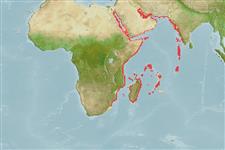>
Acanthuriformes (Surgeonfishes) >
Siganidae (Rabbitfishes)
Etymology: Siganus: Latin, siganus = a fish, rabbit fish; by the similarity of the nose (Ref. 45335).
More on author: Rüppell.
Environment: milieu / climate zone / depth range / distribution range
Ecología
marino asociado a arrecife; rango de profundidad 2 - 40 m (Ref. 12382). Subtropical; 35°N - 35°S
Western Indian Ocean: Persian Gulf (Ref.80050); Red Sea and East Africa to islands in the western Indian Ocean. Immigrant to Mediterranean via the Suez Canal.
Length at first maturity / Tamaño / Peso / Age
Maturity: Lm 14.2 range ? - ? cm
Max length : 30.0 cm TL macho / no sexado; (Ref. 30573); common length : 20.0 cm TL macho / no sexado; (Ref. 30573)
Espinas dorsales (total): 13 - 14; Radios blandos dorsales (total): 10; Espinas anales 7; Radios blandos anales: 9; Vértebra: 13. Regional variation in color exists. Anterior spines of median fins slender and pungent, posterior spines stout, all venomous including that on the nape. Preopercular angle 87-97 degrees. Anterior nostril with a long, broad flap covering posterior nostril when depressed. Variable cheek scalation. Midline of thorax devoid of scales between the pelvic ridges.
Found in small schools in very shallow water close to the bottom. Prefer hard bottoms of compacted sand with rock or coral debris. Solitary adults and groups of 3 or 4 adults have also been observed. Feed on a wide range of benthic algae. May suddenly stop and erect its fins (dorsal, anal and pelvic) presenting an encircling array of spines to potential predators; these spines are venomous. A food fish that is occasionally poisonous (Ref. 4537). Probably does not adapt well in captivity (Ref. 12382). A thermophilic species (Ref. 120766). Minimum depth from Ref. 9710.
The larvae maintain themselves near the water surface (Ref. 1419). Feeding on phytoplankton and zooplankton begins 3 days after hatching (Ref. 1419).
Woodland, D.J., 1990. Revision of the fish family Siganidae with descriptions of two new species and comments on distribution and biology. Indo-Pac. Fish. (19):136 p. (Ref. 1419)
IUCN Red List Status (Ref. 130435)
Human uses
Pesquerías: escaso valor comercial
Más información
ReferenciasAcuiculturaPerfil de acuiculturaRazasGenéticaElectrophoresesheritabilidadEnfermedadesProcesamientoNutrientsMass conversion
Herramientas
Special reports
Download XML
Fuentes de Internet
Estimates based on models
Preferred temperature (Ref.
123201): 24.8 - 29.2, mean 27 °C (based on 294 cells).
Phylogenetic diversity index (Ref.
82804): PD
50 = 0.5000 [Uniqueness, from 0.5 = low to 2.0 = high].
Bayesian length-weight: a=0.01259 (0.01013 - 0.01564), b=2.97 (2.92 - 3.02), in cm total length, based on LWR estimates for this species (Ref.
93245).
Nivel trófico (Ref.
69278): 2.0 ±0.0 se; based on diet studies.
Generation time: 5.2 ( na - na) years. Estimated as median ln(3)/K based on 1
growth studies.
Resiliencia (Ref.
120179): Medio, población duplicada en un tiempo mínimo de 1.4-4.4 años (K=0.3).
Fishing Vulnerability (Ref.
59153): Moderate vulnerability (39 of 100).
Nutrients (Ref.
124155): Calcium = 20.3 [9.9, 51.9] mg/100g; Iron = 0.568 [0.259, 1.296] mg/100g; Protein = 19.3 [18.1, 20.4] %; Omega3 = 0.196 [0.099, 0.397] g/100g; Selenium = 8.35 [3.05, 21.97] μg/100g; VitaminA = 51.8 [13.7, 186.8] μg/100g; Zinc = 1.16 [0.45, 2.44] mg/100g (wet weight);
